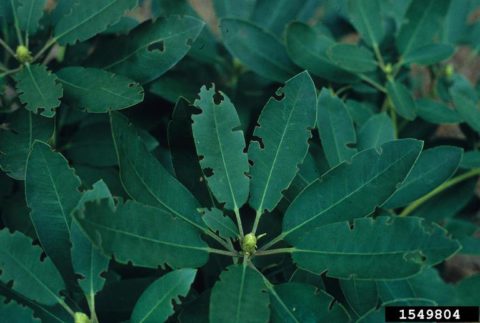
Root weevils chew leaves of rhododendrons and other broadleaf evergreens, creating unsightly notches. Photo: Jim Baker, North Carolina State University, bugwood.org.
Have you seen notching along the edges of leaves on your rhododendrons, azaleas or other broadleaf evergreens? It is likely damage from root weevils.
There are several kinds of root weevils. Three different types of root weevils chew on evergreen shrubs. In addition to rhodies and azaleas, weevils may attack pieris, viburnums, laurels, salal and huckleberries. Because broadleaf evergreens take a while to lose their leaves, the notching will stay visible for at least a few years.
Mild to severe notching of new leaves is mainly an aesthetic nuisance and will usually not damage the plant’s overall health. But it can be a sign that the plants are under stress.
How to prevent root weevil damage
The easiest way to prevent root weevil damage is to choose plants that are naturally resistant to root weevils. Plants vary in resistance, but some can be 100% resistant.
Leaf shape appears to affect a rhododendron’s resistance. Leaves that have a slight roll on the edges tend to be avoided by weevils because the roll creates an edge too wide for the root weevil’s mouth. WSU research also found that rhododendrons with dark red flowers are likely to be susceptible to root weevil damage.
See inks below for lists of resistant rhododendrons
You can help prevent insect damage to your existing plants with proper care. Since plant stress is related to susceptibility, make sure you are using the right amount of water. Young rhododendrons need frequent watering for the first few years. As they mature, they still need regular watering to stay healthy.
Organic mulch, such as compost or arborist chips, helps keep your shrubs healthy. Proper fertilization is also important.
Limiting root weevil damage
Prune up branches that touch the ground to reduce access. Root weevils need to travel along branches to get to the leaves.
Apply sticky or slippery barriers around the trunks or stems near the ground. These products discourage or trap the adults as they travel up trying to reach leaves.
Barriers work best when they are not touching other plants. They must be replaced or replenished frequently. Otherwise, organic material like leaves or dirt will collect on the substance and form a bridge for the root weevil.
The publications listed below describe how to properly use sticky barriers.
How In Harmony can help
Contact us for our natural tree and shrub care service. We use beneficial nematodes in our ongoing service. These are microscopic organisms that attack the root weevil larvae as they grow in the soil below the shrubs. This reduces populations before they become adults. Nematodes are nontoxic to plants and other animals.
The technicians look for recent damage to the leaves and apply nematodes if they see damage. Soil temperatures and moisture are right for the service at this time of year. If it’s dry and hot out, the nematodes won’t survive in the soil very long.
Resources for managing root weevils on rhododendrons
Root Weevil Control on Rhododendrons, Washington State University Extension Bulletin. Information about identification and control, along with a list of species rhododendrons that are resistant to root weevils.
Common Sense Gardening: Root Weevils, Thurston County. How to use nontoxic control methods, along with a list of resistant hybrid rhododendrons.
Root Weevils: Troublesome Rhododendron Pests, American Rhododendron Society. Information about physical, chemical and biological control methods.

What product would I buy to control the root weevils?
We recommend sticky or teflon barriers and beneficial nematodes. You can read more about nematodes in this post from OSU Extension Here is more about sticky and teflon barriers from the American Rhododendron Society.
We do not recommend the use of insecticides. Many will kill ground-dwelling beneficial insects.
What about diatomaceous earth?
Diatomaceous earth has been recommended for root weevils, but it would have to be reapplied after each rain. It may not be very practical for our damp PNW.